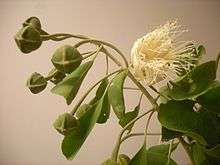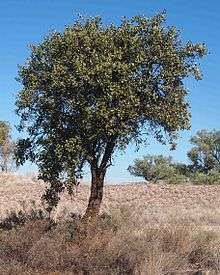Capparis mitchellii
The wild orange is an Australian native plant throughout Australia.[2] Its scientific name is Capparis mitchellii. It was named by botanist John Lindley.[3] It is also known as the native orange.[4] Its name in the Arrernte language of Central Australia is merne atwakeye. It is not related to oranges and neither to the Osage-orange which is known as "wild orange" in North America, but to capers.
| Capparis mitchellii | |
|---|---|
 | |
| Scientific classification | |
| Kingdom: | Plantae |
| Clade: | Tracheophytes |
| Clade: | Angiosperms |
| Clade: | Eudicots |
| Clade: | Rosids |
| Order: | Brassicales |
| Family: | Capparaceae |
| Genus: | Capparis |
| Species: | C. mitchellii |
| Binomial name | |
| Capparis mitchellii | |
| Synonyms[1] | |
| |

Capparis mitchellii can grow up to six metres in height with leaves between two and six centimetres in length.[4] The plant's flowers are large and coloured white or cream. It prefers sandy to clay loams but will grow on rocky hillsides.[4]
Fruit
Wild oranges are a tasty bush tucker food. Indigenous Australians made frequent use of it long before European arrival. It is green when unripe. When it ripens, it becomes soft and has a fragrant smell. The inside is yellow or orange. It is still commonly eaten in the desert today.
The 1889 book 'The Useful Native Plants of Australia records that the plant was also commonly referred to as "Small Native Pomegranate," "Native Orange," " Mondo," and that "The fruit is from one to two inches in diameter, and the pulp, which has an agreeable perfume, is eaten by the natives [sic]." It was found in all the colonies, except Tasmania and Western Australia."[5]
The fruit often suffers from caper white butterfly larvae infestation.[4] It is one of the preferred foods of the spotted bowerbird.[6]
References
- "The Plant List: A Working List of All Plant Species". Retrieved 15 May 2015.
- http://bie.ala.org.au/species/urn:lsid:biodiversity.org.au:apni.taxon:295396
- Clarke, Philip A. (2008). Aboriginal Plant Collectors: Botanists and Australian Aboriginal People in the Nineteenth Century. Rosenberg Publishing. p. 44. ISBN 1877058688. Retrieved 8 July 2013.
- Leigh, JH (2011). Plants of Western New South Wales. Csiro Publishing. p. 338. ISBN 0643103635. Retrieved 8 July 2013.
- J. H. Maiden (1889). The useful native plants of Australia : Including Tasmania. Turner and Henderson, Sydney.
- Rowland, Peter (2008). Bowerbirds. Csiro Publishing. p. 81. ISBN 0643094202. Retrieved 8 July 2013.